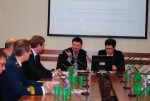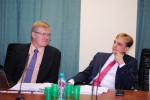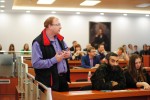Kungur Ice Cave
One of the main sights of Perm Krai is Kungur Ice Cave. The subterranean realm of stalactites and stalagmites, frozen music of ice and stone, grandeur and silence of space –everything works together to produce an unforgettable impression.
Scientists have defined the age of the cave as 10-12 thousand years. During thousands of years water has been dissolving gypsums and anhydrites of the Ice Mountain, creating a labyrinth with its splendid halls, vaults and walls carved with an invisible chisel. Due to numerous landslides the vaults of most chambers became dome-shaped.
Every year up to 80 thousand people visit the cave. The guides show visitors round spectacular chambers, all totally different from one another. Kungur Ice Cave belongs to the few caves in the whole world that have special facilities for tourism as asphalted walks and hand-rails make your travel inside the cave safer.
Peculiar branchy underground passages stretch out for 6 000 m. The length of the main “Central route” is 1 300 m; it takes on average 1 hour 20 minutes to walk this distance. During this time you will see 20 chambers, and pass through three seasons: winter, spring, autumn, and again winter in the last Tower Grotto. You will have time to enjoy the snow crystals of the Brilliant Grotto, and ice stalactites and stalagmites of the Polar, Cross, and Tower Grottos. Also you will feast your eyes on never freezing lakes of the grottos International Friendship and Long. You are sure to admire the original “art” of water that allows you to spot in the stone chaos of the Ruins of Pompeii grotto a stone tortoise, crocodile and other animals. You will hear the story of the Ice Cave formation, and of people who settled and studied it, and many interesting legends connected with the cave: about Ermak, “Lady’s tears”, and others.
The Town of Kungur
 The merchants’ town Kungur can truly be considered an open air museum, as it keeps alive the atmosphere of the Russian province at the turn of XIX – XX centuries. The town was founded in 1648, but it stood 28 km away from its present location. It was not until the Bashkir rebel in 1663 that Kungur moved to take the place between two rivers, the Sylva and the Iren.
The merchants’ town Kungur can truly be considered an open air museum, as it keeps alive the atmosphere of the Russian province at the turn of XIX – XX centuries. The town was founded in 1648, but it stood 28 km away from its present location. It was not until the Bashkir rebel in 1663 that Kungur moved to take the place between two rivers, the Sylva and the Iren.
Comfortably located at the crossing of trade communications, Kungur became a large merchant center, and since 1737 the center of Perm land. There are plenty of merchants’ houses and old churches in Kungur (St. Nicolas’, Preobrazhenskaya, Tichvinskaya, Uspenskaya, All Saints’).
This is a real tea merchant capital as the town’s prosperity was first of all connected with its lively trade in many goods including tea and sugar. In August 2007 the Museum of Merchant Class History was open to public. Near Tichvinskaya church there is a viewing site from which the town’s panorama opens. Kungur is known for its handicrafts – stone dressing and pottery.
Athos of the Urals
Belogorskiy (The White Mountain) orthodox missionary monastery of Saint Nicholas lies on top of the picturesque mountain 85 km away from the city of Kungur and 100 km away from the city of Perm. The shining of its golden domes shows pilgrims the way from the distance. The beauty and magnificence of the White Mountain is often compared to the Holy Athos landscapes, and the regulations of monastic life in Belogorye have always been strict as they were taken from the Athos model, therefore the monastery proudly bears the name of the Ural Athos.
The might, beauty, and grandeur of the monastery, as well as the unusual tale of its rise, fall and renaissance, contribute to its attractions. During its not so long history the monastery had a lot to survive and now is being actively renovated, keeping alive the old charitable traditions that existed in Perm province and in Russia at the turn of XIX-XX centuries.
Founded at the end of XIX – beginning of XX century, Belogorskiy monastery shortly became one of the biggest monasteries in Russia. Indeed, Belogorskiy monastery’s estate was vast and housed farmed lands, meadows, ponds, mills, apiaries, and more than 14 craftsman’s shops. There were an own photo laboratory and printing-house. An orphan-asylum, parish school, and alms-house for the elderly were open. The pilgrimage to the monastery reaches its height in summer and autumn, although people keep coming there throughout the year.
From the top of the White Mountain there is a splendid panoramic view of the Ural woods and hills. It has become a tradition for guests to come on orthodox holidays – Christmas, Forgiveness Sunday, Palm Sunday, Easter, Whitsunday and at other times when Christian holidays are observed. Many of the guests take home holy water from the Nicolas’ spring at the foot of the mountain. Every year at the end of July – beginning of August the Pilgrim Service of the monastery and the Perm eparchy arrange a religious procession from Perm to the White Mountain, in which many hundreds of pilgrims take part. Many people mention the special atmosphere that reigns on top of the mountain. It must be for some good reason that one hundred years ago thousands of pilgrims rushed there even though good roads were rare.






